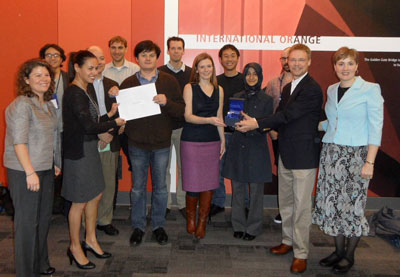BWH Team Receives International
Genomics Award

A consortium team led by the BWH Division of Genetics (pictured above) help to solve the genetic mystery of one family and receive the prestigious CLARITY award. |
Although a consortium team led by the BWH
Division of Genetics received the Children's Leadership Award for the Reliable
Interpretation and appropriate Transmission of Your genomic information
(CLARITY), the real winners of this challenge were Children's Hospital patient
Adam Foye and his family.
The
CLARITY challenge asked researchers to solve the genetic mysteries of real
families through genomic sequencing. Led by BWH's Shamil Sunyaev, PhD, the
consortium team did just that, shedding light on sixth-grader Foye's
10-plus-year medical diagnosis mystery. Through analysis of his and his
parents' genomic sequence, team members found a strong link between Foye's
rare muscular disorder, centronuclear myopathy, and titin-the largest
gene in the human genome.
In January 2012,
Children's provided 30 research teams with the medical data of three children
with rare disorders, including Foye, and their parents. The data included
whole-genome and selective genome, or exome, sequences generated by contest
sponsors Life Technologies and Complete Genomics. The teams were charged with
interpreting and analyzing these DNA sequences and communicating their results
in an effective, accessible way for the first-of-its-kind international
challenge.
"We had very
different types of people collaborating together, including basic scientists,
physicians, clinical geneticists, computational biologists and more," said
Sunyaev. "We wanted to assemble a team that covered a variety of experiences
and expertise. This was the key; we had people who usually don't work together
collaborating in the same room."
While many entries received high marks, the
BWH consortium team was judged to have the best combination of cutting-edge
bioinformatics analysis, clarity and utility of its clinical reports for the
three families, while also identifying the likely mutation for Foye's disorder.
The team included individuals from the Division
of Genetics, MGH, Partners Laboratory for Molecular Medicine, Brown University
and Utrecht University in the Netherlands.
The team's
findings will likely help Foye's physicians eliminate other potential mutations
and move forward with the hope of an effective treatment.
Sunyaev and his
team plan to keep up the momentum of the challenge win and continue to meet to
refine their work.
"We
hope to come up with a table of the most important things to consider in the
interpretation of genomic data, and share this information," said Sunyaev.
"This could streamline the analysis of future cases; hopefully others could
also benefit from our tools of analysis.